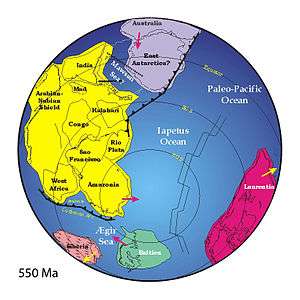Baltica
This article is about a continent. For other uses, see Baltica (disambiguation).

Baltica 550 mya (green)
Baltica was a late-Proterozoic, early-Palaeozoic continent that now includes the East European craton of northwestern Eurasia. Baltica was created as an entity not earlier than 1.8 billion years ago. Before this time, the three segments/continents that now compose the East European craton were in different places on the globe. Baltica existed on a tectonic plate called the Baltic Plate.
History
- ~1.8 billion years ago, Baltica was part of the major supercontinent Columbia.
- ~1.5 billion years ago, Baltica along with Arctica and East Antarctica were part of the minor supercontinent Nena.[1]
- ~1.1 billion years ago, Baltica was part of the major supercontinent Rodinia.
- ~750 million years ago, Baltica was part of the minor supercontinent Protolaurasia.
- ~600 million years ago, Baltica was part of the major supercontinent Pannotia.
- ~Cambrian, Baltica was an independent continent.
- ~late Ordovician, Baltica collided with Avalonia (most of modern Western Europe)
- ~Devonian, Baltica collided against Laurentia, forming the minor supercontinent Euramerica.
- ~Permian, all major continents collided against each other to form the major supercontinent Pangaea.
- ~Jurassic, Pangaea rifted into two minor supercontinents, Laurasia and Gondwana. Baltica was part of the minor supercontinent Laurasia.
- ~Cretaceous, Baltica was part of the minor supercontinent Eurasia.
- ~Present, Baltica is part of the forming minor supercontinent Afro-Eurasia.
See also
References
- ↑ Carl Zimmer (January 1997). "In Times of Ur". Discover Magazine. Retrieved 2 February 2016.
External links
This article is issued from Wikipedia - version of the 5/15/2016. The text is available under the Creative Commons Attribution/Share Alike but additional terms may apply for the media files.
.svg.png)
.svg.png)
.svg.png)
.svg.png)


.svg.png)
.svg.png)
.svg.png)
.svg.png)
.svg.png)